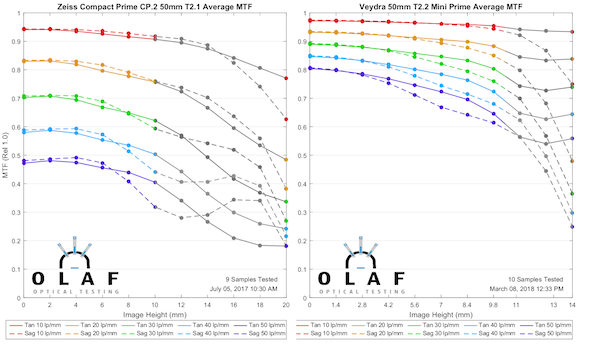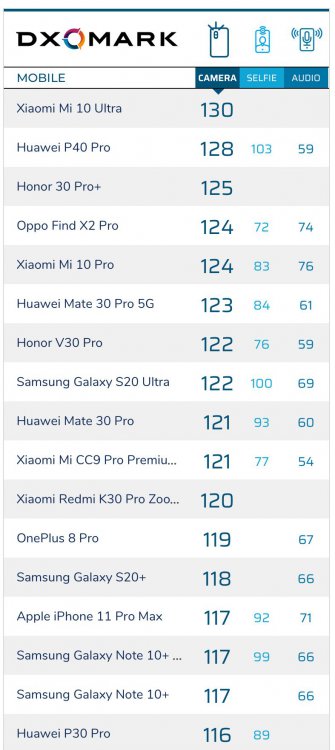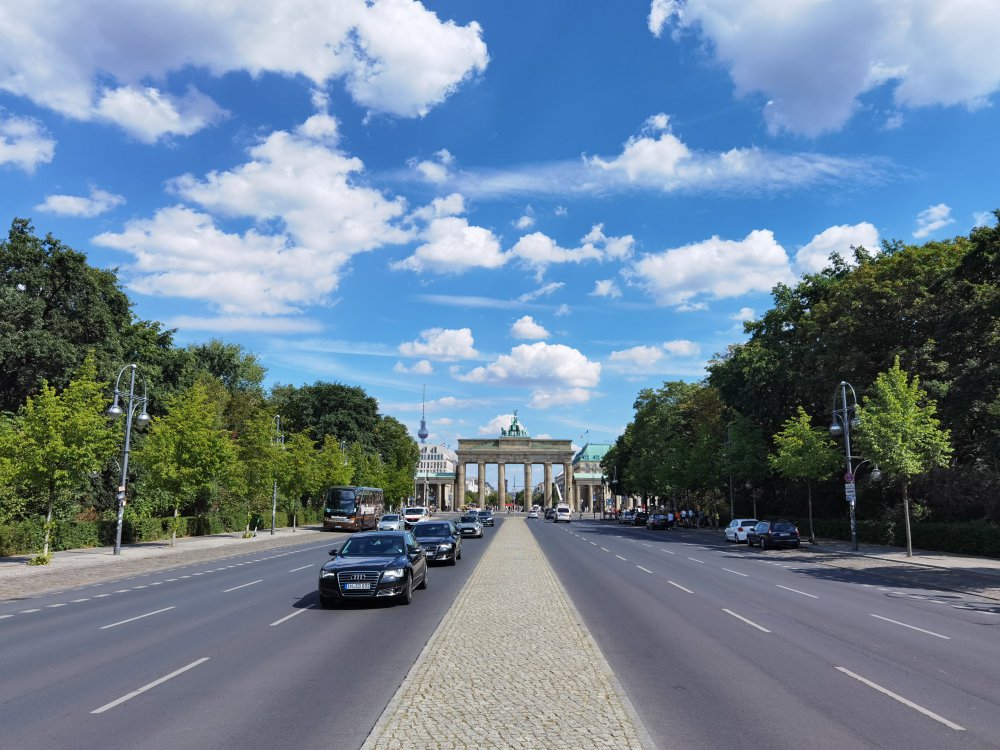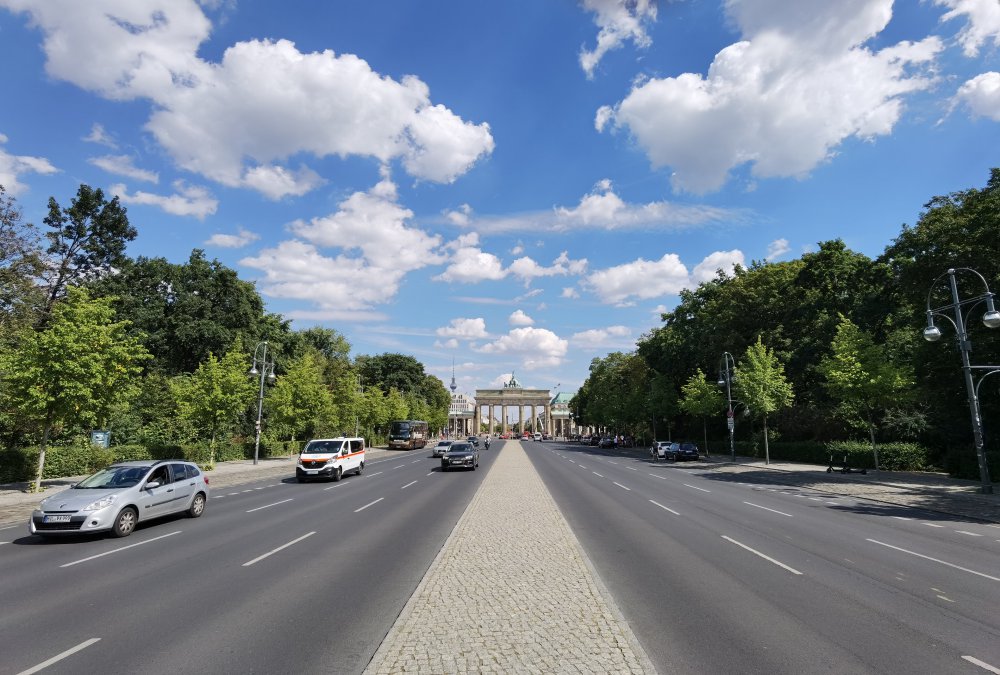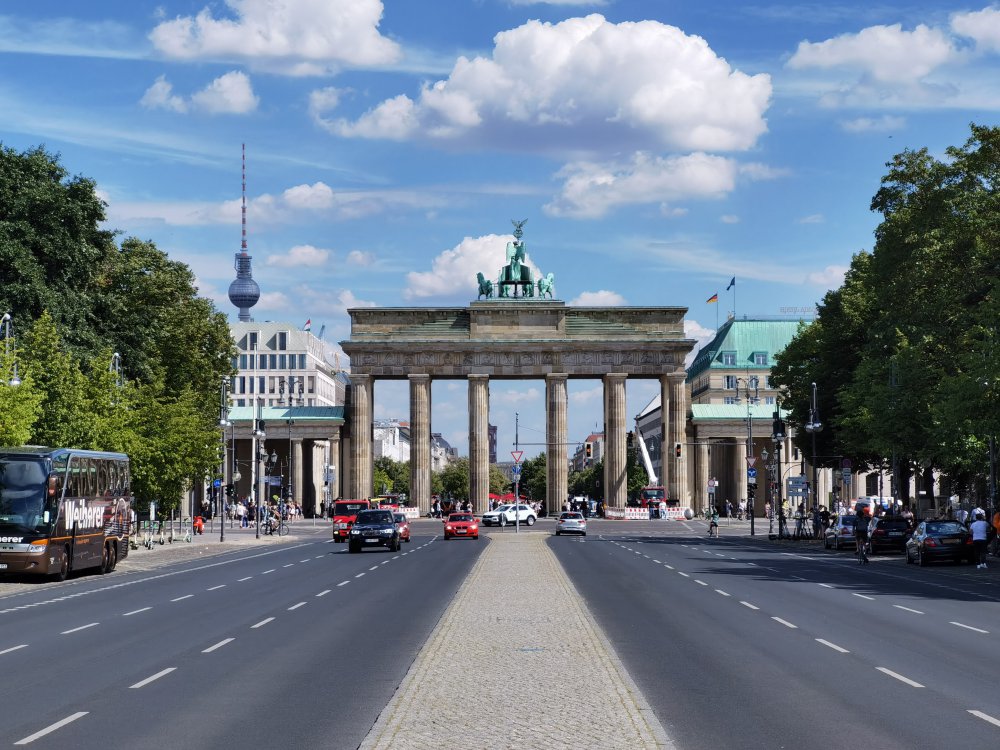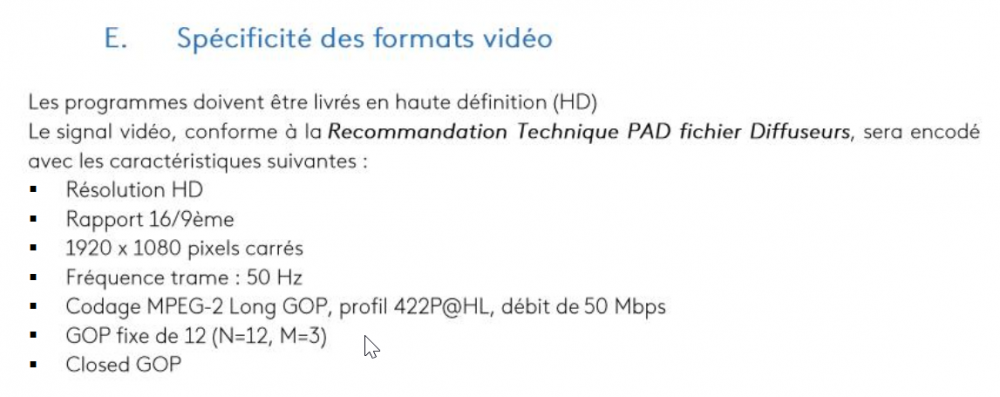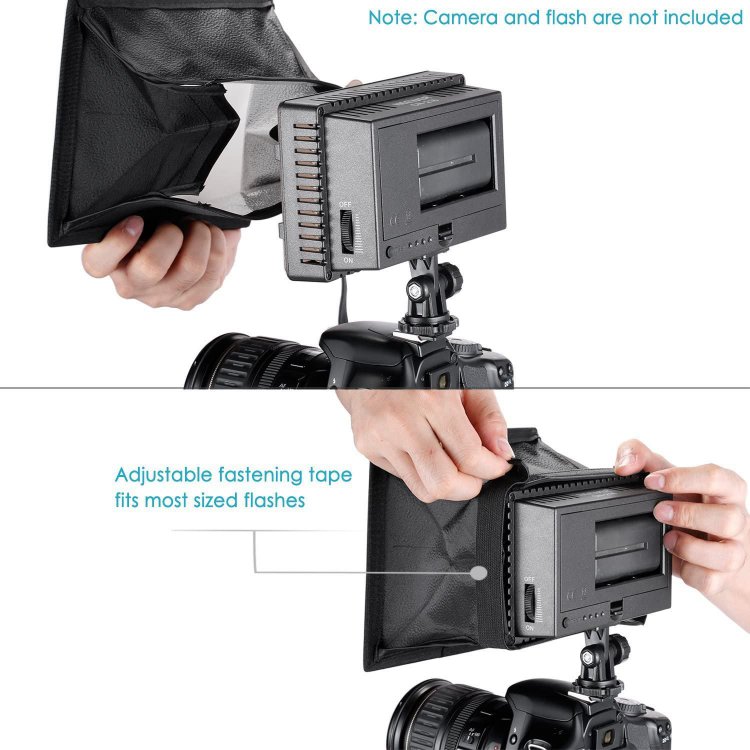Leaderboard
Popular Content
Showing content with the highest reputation on 09/08/2020 in all areas
-
Panasonic in trouble?
MicahMahaffey and 4 others reacted to Dimitris Stasinos for a topic
I am getting goosebumps only by thinking this. It’s the only established company right now that prioritizes usability and reliability on low cost hybrids. I am going to buy the S5 and ignore the R6 and whatever Sony will announce this month.5 points -

Canon EOS R5 / R6 overheating timers, workarounds, and Magic Lantern
dgvro and 4 others reacted to Andrew Reid for a topic
UPDATE: I have tried the date/time trick without defeating the battery door sensor. Just pull the battery as normal and it works. https://www.eoshd.com/news/magic-lantern-users-create-practical-canon-eos-r5-overheating-timer-workaround/5 points -
Canon EOS R5 / R6 overheating timers, workarounds, and Magic Lantern
PabloB and 4 others reacted to newfoundmass for a topic
"Solved" or not, this is utterly ridiculous and no one should reward Canon with their business even if these cameras are your ideal tool. Please, reward honest and ethical companies with your business. It is the only way things will get better for all of us.5 points -

Panasonic in trouble?
jack jin and 3 others reacted to Andrew Reid for a topic
Panasonic were first to the mirrorless market but late to the full frame mirrorless market. They need to take a long term view and hope that Canon RF / Sony E-mount lenses don't come to dominate. The lenses are very important. Panasonic have made great cameras, and in Micro Four Thirds had a great range of optics at all price levels. With the S-series optics they are starting all over again, but E-mount is already very well established. This is a problem. Sigma are competition in their own backyard with more appealing lenses across the board at better prices. With Leica and Sigma on board, L-mount has a enthusiast and professional niche of customers, who will be around long after the mainstream has moved on from cameras entirely and Canon has gone back to concentrating on medical and selling photocopiers. But if Panasonic want to compete for Sony and Canon proportions of the market in terms of volume, I think they need to take the long term view... And get people on board with the L-mount system. Lacking phase-detect AF or good AF with EF lenses doesn't help. Fundamentally I think Panasonic can only continue to move forward in cameras. It is Nikon I am more worried about!4 points -
I've created a web-based javascript app that lets you quickly set the camera's clock to +1 day and -1 day to help automate visionrouge's workaround. It only works in browsers that allow you to disable CORS Policy Security. Unfortunately none of the mobile web browsers available support that option, so for now this is limited to home/office/studio use. Here is the link to the app: http://www.testcams.com/ccapi/datehack.html Full instructions including how to disable CORS Policy security are in the GitHub repository: https://github.com/horshack-dpreview/canondatehack.html3 points
-

Is full frame really necessary?
dellfonic and one other reacted to Trek of Joy for a topic
Its such an individual thing, its an impossible discussion to have - hence the millions of mind-numbing arguments about equivalence. They're all tools that can get the job done. IMO the best balance of IQ with camera/lens size and cost is FF for stills and now - for me - video too. I need great AF, and really don't want to juggle two (or more) sets of lenses anymore. Now that FF cameras have some mind blowing video specs, its all come together - again for me. Personally I like the look of a fast wide, my 24 or 28/1.4 is my favorite, and I can only get that on a FF. Fuji's 16/1.4 and various m43 options come close, but its just not the same. I can't imagine the size of a Fuji equivalent to Sony's minuscule 24/1.4 GM since they said the 33/1.0 needed a tripod collar for support and was too large/expensive to make a reality. The new 50/1.0 is huge. I like the creative options with shallow DOF at times too, and again its much easier with FF. But I recognize everyone has different needs, I'm not trying to say one is better, I just prefer the IQ and aesthetic options FF gives me. The arguments against FF years ago - mainly big/expensive lenses and bodies - are a thing of the past when you look at the Tamron zooms and lenses like the Sony 20G, 24GM, 85 1.8 and so on - compared to Olympus Pro primes or something like that new Fuji 50/1.0. Unless you shoot Panasonic's S lenses LOL! Its easy to go small/light, or no compromise with IQ or speed and thanks to so many jumping in on the E-mount, there are more 3rd party options than anything on the mirrorless side. I'm deliberately ignoring DSLR stuff because I don't shoot anything with a mirror anymore. But when you look at the popularity of speedboosters, lots shooting sensors smaller than FF are still looking for that FF aesthetic. IDK, just my perspective. As always YMMV. Chris2 points -

Canon EOS R5 / R6 overheating timers, workarounds, and Magic Lantern
Coffe and one other reacted to Marcio Kabke Pinheiro for a topic
Roger put a very detailed disassembly on LensRentals right now. https://www.lensrentals.com/blog/2020/09/taking-apart-the-canon-r5-mirrorless-camera/2 points -
I'm not sure the FF equivalence is a particularly relevant one in terms of cine lenses as the vast majority of them are still only Super35 coverage (as are the Meikes despite the MFT mount) so in terms of that norm I wouldn't consider T2.2 to be "very slow". In terms of separation, I've just put my 18-50mm T3 PL zoom on a Super35 camera to illustrate similar sort of focal lengths that you might typically buy the Meikes in and even with this significantly slower lens there is still a good balance, for my tastes at least, between separation and obliterating the context of where it actually is in terms of its surroundings, even at the wide end.2 points
-

Panasonic S5 Entry Level Full Frame seems to be real...
currensheldon and one other reacted to Trankilstef for a topic
So I took the plunge. One Panasonic ambassador told me about an interesting offer with a shop in France. Besides the Panasonic offer with the Sigma 45mm offered for free, this shop will give you 3 years more warranty + a free battery. I thought it was a good deal so I pre-ordered it. I am pretty sure I would do it as I need another body to complement my S1H but this offer made me purchase it right away. So it should arrive by the end of september/beginning of october. I will put it through its paces as I have some interesting jobs coming along, especially one shooting a documentary for the french national television service (France Television) if it is delivered in time. So I'll give you all my first feedback really quick I think. Pretty excited by this camera as it is the one I was waiting for in the L-mount system : a smaller camera than my S1H that could still shoot awesome video to match with the bigger brother, being quite smaller to be my B-cam/gimbal cam, also my main stills camera, and one that I could bring everyday to shoot some street and mundane photography (without the hassle to release the S1H from the rig/cage between pro gigs) and one camera that I could take on vacation without sacrificing any quality in stills picture and video.2 points -
Andrew, I have been a follower since Magic Lantern days with the 5DMK3. I recently bought BMPCC 4K & 6K and now a Canon R5. I want to tell you how much I appreciate all your genuine concern and hard work in getting a fix for this camera. Though I am an attorney by day, I shoot a far amount of singer-songwriters-musicians in concert and limiting the use of the camera to 29.59 seconds is unworkable. Lets hope this limitation can be defeated also... Keep up the great work. I'm looking forward to a R5 manual from you too. Peace, Joe Ray Skrha, Kenai, Alaska2 points
-
That was a great lens comparison. Now that we know the Meike lenses use the same formula as the Veydras, it's worth taking a second look at just how well the Veydra lenses performed in the LensRentals MTF optical bench tests. https://www.lensrentals.com/blog/2018/03/veydra-cine-mini-prime-mtf-optical-bench-tests/ The comparisons to Zeiss CP.2 lenses is particularly interesting as seen in the attached sample.2 points
-

Canon EOS R5 / R6 overheating timers, workarounds, and Magic Lantern
PabloB and one other reacted to Andrew Reid for a topic
It is a standing on the shoulders of giants effort - as a1ex said on the ML forum. I don't think it's helpful for any individual to claim the plaudits. People should be careful about making money from information that should be freely shared. And people should rightfully feel miffed if their groundwork, effort and graft is not acknowledged or credited in later discoveries... Because it's all a collaborative chain. Anyway the most important thing is that it progresses towards a usable solution, as is happening... Meanwhile Canon continue to blank us and in the case of Gerald Undone after his review which covered overheating in-depth, completely ghost him. Meanwhile a site like DPReview which has toed the PR line and not contributed anything to the discourse, get rewarded with thousands of USD via marketing agreements and sponsored content like the EOS R6 video today. Fair? No. On ethical grounds I will be very reluctant ever to buy another Canon product again.2 points -
Panasonic GH6
Mmmbeats and one other reacted to Video Hummus for a topic
I’m sure they will have one headline feature all the news outlets can slap in the title. I’m glad they are saying things like (paraphrasing): “we are looking at making the most out of the advantages of MFT”. That is exactly what they should be doing. That has traditionally been: Telephoto video (balance of size weight, and image quality for out in the field work; wether stealthy street or nature). Can’t walk around with a FF 400mm without getting attention. Fast sensor readout Smaller sensor with theoretically less thermal overhead and more robust IBIS. The new “best in class video features for mirrorless” today would be things like 6K60p (fast sensor readout), internal ND, unlimited recording (thermal overhead), IBIS (smaller sensor easier to stabilize in body). But yes, I would like a mini S1H with HFR 6K recording, 4K120p (a must), an internal ND solution, unlimited recording in full vlog with varicam lineage color science, and DR in the 12-13 stop range. That really would be a really exciting and solid camera. I am kinda grateful the R5 and A7SIII are as good as they are. The bar is raised. It’s time for Panasonic to leap over it like they traditionally have with GH cameras, even if it’s the last MFT camera they make because of the shifting market.2 points -
So.... It's obviously no secret that alongside developing the AFX add on, we've also been busy creating a version of it with an interesting additional feature. More development details will be announced about it when the AFX is available for pre-order. In the meantime, here are some examples of the additional feature. Can you, erm,"detect" what that additional feature might actually be doing?2 points
-
We can start the discussion from possible many angles indeed... let alone the customary DOF or use of slower glass and strictly going from a low light perspective?1 point
-

DXOMark mobile camera rankings corrected
tomastancredi reacted to Andrew Reid for a topic
A nice side project... Mobile camera tests. It's good fun. I have so far tested: Xiaomi Mi 10 Pro Xiaomi Mi 10 Huawei P40 Pro Plus Huawei P40 Pro Huawei Mate 30 Pro Samsung Galaxy S20 Ultra iPhone 11 Pro Max Samsung Note 10+ Oppo Find X2 Pro (OnePlus 8 Pro is very similar) I'll keep it short. The big blog post is coming soon. But the DXOMark chart is wrong 🙂 Here's my EOSHDMark ranking: Huawei P40 Pro - 150 Pros: Superbly useful 5x zoom, overall camera quality, nice colours, price. Cons: IR pollution, screen size could be a bit bigger Huawei P40 Pro Plus - 150 Pros: Low light, overall camera quality, nice build. Cons: Lacks 5x module from P40 Pro, 10x module too long for regular use Huawei Mate 30 Pro - 140 Pros: Main camera again is superb like P40 Pro and 3x telephoto not bad either. Nice Samsung Note-like form factor & screen. Cons: Lacks 5x periscope camera of P40 Pro and overall zoom quality Xiaomi Mi 10 Pro - 135 Pros: 8K video and very good main camera, superb screen. Cons: Colours can be a bit clinical, a bit flat, 5x zoom quality is lacking compared to Huawei, back feels & looks cheap Xiaomi Mi 10 - 130 Pros: 8k video and very good main camera, superb screen. Cons: No 3x or 5x zoom modules and back feels / looks cheap. Oppo Find X2 Pro - 110 Pros: A good all-rounder, decent 5x zoom, market leading 3K 120hz screen. Cons: Poor tonality. Oversharpened camera output, beaten by Huawei. Poor choice of back material / weird finish iPhone 11 Pro Max - 105 Pros: Good dynamic range, natural colours, iOS, great build. Cons: Camera hardware dated compared to Chinese competition, poor zoom capabilities. Samsung Note 10+ - 100 Pros: Nice colours and decent main sensor, great form factor. Cons: Dated camera hardware especially compared to Huawei. Samsung Galaxy S20 Ultra - 95 Pros: Great in-hand feel and wonderful screen. Cons: Camera processing feels unfinished and is a complete let down, especially in low light. Mediocre 5x periscope zoom is soft. Main camera is muddy in low light and feels overly binned & over sharpened in good light. Xiaomi Mi 10 soundly beats it with same sensor! Expensive too! Google Play Store and Google Services installed OK on the Huawei phones. Couple of surprises: P40 Pro 5x optical zoom is the best on the market. Unfortunately they went crazy with the Plus version which is the flagship ($1000+) handset. That has a 10x optical zoom (240mm). It's way less useful than the 5x (135mm). Also the Plus version has a 3x optical zoom camera module, but I'll take the 5x over that any day. The other area of surprise is with colour - the Leica profiles on the standard P40 Pro are less "consumer". Much warmer and more day-glo on the Plus. One area where the Plus does win though is with build quality and low light. Also, there's fewer colour casts and less IR pollution indoors with black fabric, which come out almost purple on the P40 Pro. Also the P40 Pro has quite a cool and quite a green cast sometimes, especially in artificial light - and some will prefer the P40 Pro PLUS here. I find the P40 Pro quite artistic and moody looking though. One thing is for sure - 10x optical zoom lens on a smartphone is quite unique on the market - and when you have a use for it, it does deliver the goods for sure. Xiaomi Mi 10 Pro / Mi 10 / Samsung S20 Ultra share similar 108MP sensor. Xiaomi THRAAAASHES the Samsung. They just get much more out of it. Especially in low light, where the S20 Ultra is a mushy mess. Even the old Note 10+ has a preferable look in most circumstances to the S20 Ultra, and to make things worse the 5x optical zoom (actually more like 4x glass) is mediocre at best and significantly softer than the P40 Pro. Also the 8K video on the S20 Ultra is heavily cropped and looks dreadful, whereas the Mi 10 and Mi 10 Pro don't have a crop and again get much more out of the sensor in the processing. It is not 8K that pixel peeps well but it does make for very good 4K, even in low light. Downsides to the M10 Pro... the 5x zoom is pretty mediocre and noisy... and the Mi 10 makes do with nothing beyond 2x. Great screens though. Oppo Find X2 Pro puts in a good effort but it just looks brittle and thin compared to the Huawei on the main wide angle sensor. The ultra wide isn't as good either. The 5x is pretty good - nice and detailed, but dynamic range and colour lag behind the P40 Pro 5x. Indeed, the main sensor output fairs better for dynamic range but not for colour and it is a very over-sharpened output. I like the Oppo implementation of Android. Shame about the boring design of the back and the odd texture of the glass (has a kind of scratchy feel). Absolutely amazing 3K screen running at 120hz but not as bright in direct sunlight as the Xiaomi Mi 10 Pro and Mi 10 standard. There's a bit of a gap from the Huawei phones to everything else in my view. Especially with regards to tonality and the large 1" sensor look. Also the lenses are less flare prone when not absolutely grease free, compared to the Mi 10 Pro which is particularly badly effected and the Find X2 Pro. The iPhone 11 Pro Max fairs best for flare. The Apple device still has great dynamic range and the most natural looking colour - almost a flat look, good for filters. However it is distinctly backward from the Huawei and has that 'small sensor look' to it. The zoom is a complete non-starter against the 5x folded optics in the Huawei. I hope this helps anybody looking at the top 10 of DXOMark. The Xiaomi Mi 10 Ultra I have not yet tried but output looks a bit brittle and thin compared to the Huawei P40 Pro to me, judging by their own samples on the site. The zoom looks good. It shoots 8k. I shall have to try it. Oh and the Mate 30 Pro is my choice for a more "Note 10" handling style of Huawei phone - The main sensor is just as good as the P40 Pro in my opinion. Colours seem a bit closer to the Plus than the standard P40 Pro. Sometimes too consumer. But sometimes better with improved WB and less casts in low light. The 3x zoom is good in daylight. Less so in low light. It doesn't have the wow factor of the 5x on the P40 Pro though. I really wish Huawei had kept the 5x zoom on the P40 Pro Plus with the lovely build quality and ceramic back. I really wish they'd corrected the colour casts and IR pollution without throwing out the "Leica look". It can apply HDR too strongly sometimes even in the Leica profiles. The P40 Pro standard model does this too sometimes but not as often. Maybe they couldn't fit the 10x module and 5x into one phone!! DXOMark's numbers are too close together and don't reflect the differences in main sensor image quality well enough either: P40 Pro - 128 X2 Pro - 124 Mi 10 Pro - 124 Mate 30 Pro - 123 S20 Ultra - 122 The biggest problem is that S20 Ultra score - there is no way it is even in the same league as the others, especially in low light. Mate 30 Pro is significantly more than 1 point better than the S20 Ultra. Also there should be more than 4 points between the P40 Pro and the Oppo Find X2 Pro.1 point -
These cameras are the most affordable filmmaking deal ever... AF related included ;- ) Can anyone be outside of this offer even today? - E. (Pocket cameras lover and Canon shooter as well, owner of 11 Panny still kickin' today)1 point
-

DXOMark mobile camera rankings corrected
andrgl reacted to Andrew Reid for a topic
1 point -
Haha holy crap dude, can't believe that you are still gonna do this. Thank you very much for the sacrifice bro. I also do wonder what the 4000, 6400 and 12800 looks like in vlog, so if you can maybe shoot some footage at those iso levels as well that would be amazing. Thank you so much!1 point
-

Panasonic GH6
Video Hummus reacted to sanveer for a topic
Quote the shocker, if it's TRUE. Suicidal, if you ask me. It will take both FF and M43 down, if true.1 point -
Panasonic S5 Entry Level Full Frame seems to be real...
Trankilstef reacted to Kisaha for a topic
indeed, thank you very much. They recently started asking for double delivery in Greece, 1080 and 4K, even though there is no 4K channel! Maybe they are thinking slightly ahead, which is surprising for anything Greek! Was that so difficult for Canon to offer these settings to the C200?!! Sorry for the off topic.1 point -

Panasonic S5 Entry Level Full Frame seems to be real...
Kisaha reacted to Trankilstef for a topic
1 point -
1 point
-
1 point
-

Canon EOS R5 overheating vs Panasonic S1H and Sigma Fp designs
mechanicalEYE reacted to Emanuel for a topic
To those wondering on topic as much as me, here is:1 point -

Is full frame really necessary?
IronFilm reacted to Trankilstef for a topic
For video I personnally super 35/APS-C is the sweet spot. I really like micro 4/3 too for video. But I can't really appreciate taking stills on a crop sensor. For now I only use mirrorless bodies for my stills business and for my filmmaking business (except when I need to rent a certain camera for a project). But if I would buy a proper video camera, I'm pretty sure I'd go for a super 35 camera like the C300 MkIII for video and keep a full frame camera for my photography.1 point -

Canon EOS R5 / R6 overheating timers, workarounds, and Magic Lantern
Emanuel reacted to mechanicalEYE for a topic
Add me to whatever list exist for the R5 visionrogue workaround works. I'm on firmware 1.1.0 with, and without the battery grip. Camera overheat warning flashes, make date change, pull battery, and then all times reset for all modes.1 point -
Panasonic in trouble?
Juank reacted to Video Hummus for a topic
E-mount already dominates. RF sells because it is...well...Canon there are a ton of Canon enthusiasts who will buy anything from them. I think they work closely together to fill out the system. It’s curious the Sigma fp and S series cameras don’t really step on each other’s toes. At this point any traction in L-mount, wether sigma selling glass or Panasonic, is good for the mount’s future. Leica is in a good position at the moment. They control the L-mount. Panasonic and Sigma cameras are a potential “gateway drug” for users wanting to buy a Leica L-mount camera (other L-mount glass will work on it) so the investment is less. They sell their name to be attached to lenses without doing much at all except making sure they don’t soil their good name with crappy performance. I think if anything, Leica needs to lend something more to the L-mount besides their name if they want it to survive. The relationship between Leica, Panasonic, and Sigma already existed before the alliance. I think many of the PL lenses were perhaps designs by either Leica or Sigma, manufactured by Sigma or Panasonic, and sold under the Panasonic Leica name for Panasonic cameras. The companies have proven they can work together, I just think Leica could do a lot more to promote the mount. This is the single biggest reason, by a long, long mile, that Panasonic doesn’t break into the professional market. If the S5 had competent PDAF it would be hard to ignore for people waiting to see Sony’s A7IV hybrid and how things shake out with the R5/R6. It would at least be on peoples top 3 lists. Even if you don’t use AF it has become a required feature in any camera. It’s like Bluetooth in cars now they just all have to have it and it has to work well. I really do believe, if Sony doesn’t cock up the A7IV, that after that camera is released the market will shift in their favor for the years to come. Many many people in the wedding and event shooting scenes are going to migrate to a A7SIII and A7IV. They have all the features people want and need right now and best in class performance. Sony has done an amazing job with their AF since the A7SII.1 point -

Sony A7SIII a7s3 A7 Mark III Official Specs/Pics
Kisaha reacted to Trek of Joy for a topic
Your needs aren't everyones. I just sent some stuff to an agency for print/digital work, a cropped image from the a73 that was about 16mp and they asked if I had a larger version. Sometimes I need a heavy vertical/horizontal crop for things like banner or sidebar type ads, so most of the image is thrown away. Even with 24" prints there's a noticeable difference between 42mp files from the a7r2/3 and the 12mp files from a7s2, I shot both extensively and its easy to tell which camera shot which image. This "normal viewing distance" stuff people constantly throw out is bullshit. I've found people constantly get right up against a print and look at the details, for me more is better and it has zero to do with poor composition. Its about getting the end product I want, even if I need to crop. Sometimes I look at a shot and see a second image that's completely different just by cropping a large chunk out. I shot tons of safari stuff and cropping to get details like a tight shot of a face or texture in feathers gives an entirely new perspective, same when I shoot automotive stuff. I do the same thing with landscapes too, lots of times you can just crop the foreground and get a dramatic sky shot without wasting sunrise/sunset light trying to reframe to get different angles. Most of the time I'm chasing a short window of perfect light, I don't waste it reframing and moving around, I just crop. I like the creative freedom more mp gives me. The s3 - for me - is going to be for video and social photos only. I need more mp for my regular work, the a73 is minimum for my stills work. YMMV. Chris1 point -
Is full frame really necessary?
Sharathc47 reacted to David Bowgett for a topic
It's not needed, but right now it's the direction the industry seems to be moving in. Only Fujifilm and, weirdly enough, Canon really seem to be pushing the boundary in terms of APS-C sensors right now, and things have been even slower on the m4/3 front.1 point -
Indeed, this is really impressive: Here's another comparison as food for thought:1 point
-
Nice with 3 year warranty & extra battery! I also pre-ordered today, the free Sigma 45 2.8 is too good to pass, my friend pre-ordered the body and Sigma 24-70mm 2.8 L mount combo.1 point
-
This has NOT worked for me on the R6. A battery door hack/ dummy battery is needed. https://www.magiclantern.fm/forum/index.php?topic=24827.msg230592#msg2305921 point
-
All products from China must be well evaluated, because the Chinese government is acting with aggression compared to other democratic states ... If you buy a Chinese vacuum that scans your home, which is saved on a Chinese server ... I would say the problem exists!1 point
-

Panasonic in trouble?
Trankilstef reacted to Emanuel for a topic
I hope everything will end okay, I still have my money with them.1 point -
Are they the same formula? In the previous video (comparing the Meike with the Veydra) he notes that the Meike has scarified the close focus distance to eliminate focus breathing, which would lead me to believe that there is at least some difference in the design, possibly only element spacing, but maybe more. Here's the part I'm talking about: Nevertheless, I think it's reasonable to suggest that the Meike performance is excellent. The comparison to the Zeiss CP2s is interesting, because it really depends on what you're looking for. My experience is that there are five schools of thought when choosing lenses: Choosing lenses that offer resolution but have flattering (ie, lower) levels of micro-contrast as this is flattering on skin texture. This is a significant force in high-end cinematography with the classic lenses being very popular in rental houses. Choosing lenses that are very sharp and very neutral in order to be combined with optical filters like diffusion filters or nets to get a flattering level of micro-contrast in-camera but also have it be adjustable, where with lenses it is much less-so. This is also popular in larger budget productions. Choosing lenses that are very sharp and very neutral to get the cleanest image out of the camera in order to process it in post with diffusion and other image tuning effects in post. I've heard of this in rare instances where someone knows the power of their preferred colourist and is willing to invest in more time and cost in post because of the fine-tuning possibilities. Choosing lenses that are very sharp and very neutral to get the cleanest image out of the camera because the aesthetic is suitable for the project. This is sometimes the case in larger budget productions, but is more the norm in lower budget productions like documentaries where the emphasis is on the content and the capturing is meant to have a more neutral tone. Choosing lenses that are very sharp and very neutral to get the cleanest image out of the camera because that's what stills photographers obsess over and the rationale of the person hasn't progressed beyond the idea that film-making is just taking many photographs very quickly. I find this to be the dominant mindset on internet forums. Of course, it's more complicated than just resolution and micro-contrast, but those seem to be the two dominant factors that drive most of the decision-making. I also noted in the big comparison that I did that some of the more revered lenses had higher resolution than average when wide-open and lower resolution when stopped down than the average lens, making them more consistent over their aperture range than the average lens, which is much softer wide open and much sharper when stopped down.1 point
-
Just catching up on what is probably already old news on this now. The firmware update "fixing" overheating is exactly the sham I was saying I was wary of. Get a few youtubers with a big neon "Overheating Fixed????" in their video thumbnail and there's just enough misinformation then to keep people buying the product. After those initial first wave of remorseful people who got the thing already, of course. Quick firmware updates that don't really change anything (Fuji XT4 IBIS anyone? IS Boost suddenly does worse than nothing? NOT fixed) and nobody's sure what to believe anymore. "Oh but I heard they fixed it?" Hope it gets hacked to bits like the GH2 and people who have bought it get a workhorse to grow into for the next 10 years instead of buying another canon body.1 point
-
With this module, in the wide mode example, you can see that it begins tracking the face even before she enters the frame as it has a wider field of view than the camera. The standard mode AF-C mode only takes the focus when she is more centrally framed and the AF-S mode only activates on depression of the trigger akin to AF-On/Back Button Focus. on a DSLR. In either AF-C mode it will track wherever the target goes while you have that engaged, which is alsi switched in and out by the trigger on the small controller. In all these modes, the variable transition time is also active. I do have plenty of geared compact and cine PL lenses to test with but this version is direct control of electronic lenses on the Pocket cameras, a version to control motors will follow.1 point
-
Development Update - AFX Focus Module For PBC
Emanuel reacted to A_Urquhart for a topic
Looking good! I know this is just a little teaser but I'd love to see how this version tracks a person moving around the frame, toward and away from the camera. Focusing manually between two fixed points is easy and still produces a more organic focus pull but I can see this being more useful to track a person moving in frame or when on a moving gimbal. Do you have any geared manual only lenses to try this on?1 point -

How to better diffuse those compact LED lights?
filmmakereu reacted to BTM_Pix for a topic
1 point -

Canon EOS R5 / R6 overheating timers, workarounds, and Magic Lantern
LukeM reacted to Andrew Reid for a topic
I don't really understand what you are saying. Anyway, yes it's great that the community and individual users put in the hard work and came up with a workaround so you can feel better about giving $4000 to Canon now... a company that in my opinion lied to their customers, refused to apologise, refused even to acknowledge anything was wrong. They are not off the hook. An official fix and apology is the only path back for them in my eyes, and whatever little reputation their sales & marketing people have left in terms of honesty. In my opinion they knew they'd played fast and loose with consumer law as well - which in my opinion was what the latest firmware update was all about - ensuring that they couldn't be sued in a class action by not measuring temps in the first release of the camera. In my view, the second firmware adds the temps into the mix in a pretty superficial way just so they can claim it's actually about temperature and thermal protection! Disgusting behaviour! Let's never lose sight of that and stop demanding that they come clean.1 point -

Canon EOS R5 / R6 overheating timers, workarounds, and Magic Lantern
Vavid Cincent reacted to visionrouge for a topic
No, No need to do anything It's very simple. Canon do a very simple calculation. When camera is running, a counter is setup. When the counter reach a certain level, you have a warning logo. If you keep recording, the Log will become a shut down. This raise a flag that I will call "Fake Overheating flag" At each of these step Canon is writing the exact time this occurs. Let's call it the "overheat start time". This is done in an eeprom that is kept even if you remove the battery. The writing occurs when you shut down with the power button. This is the mistake right there. There are only one way of getting the camera to work again is to wait extra time. Canon do a simple calculation between "actual time" and "overheat start time". This way, even if the camera is off without battery, they can keep the time running with the help of the RTC. It's a way of doing coding something very fast. They also put a conditional test on "Fake Overheating flag" to make sure changing the time during the overheat mode will not change this calculation. My best guess is that they modify the "overheat start time" with the same value the camera time is shifted in this condition only. So each tentative to play this way is not working. But I have the impression that the new "overheat start time" is written ONLY when the camera is power down. The new real time is written immediately. So by dropping the battery, you are avoiding the "overheat start time" to be written and only the last one is in the memory. When the power is restored, there is the calculation to see if you have been waiting enough. But based on the old "overheat start time", not the one shifted by the time modification. BOOOOM. So the flag is now remove and the camera can start. Even better, The camera is writing this new "Fake Overheating flag" value into the EEprom. So you can turn off the right way and it will restart without any problem. You can now shift the time back, there is no check for a possible "overheat start time" cause we are not supposed to be in overheating mode. So whatever card you are using, whatever R5 or R6, whatever firmware... it's working. That was my idea at first when I noticed that the battery drop do not save all parameters. An yes, it works so beautifully.1 point -
Great test of (almost) all the Meike MFT lenses:1 point
-
1 point
-

Canon EOS R5 overheating vs Panasonic S1H and Sigma Fp designs
Juank reacted to Andrew Reid for a topic
This is a good post. CFExpress cards do get very hot to the touch. So not surprising to see that they have built in overheating protection. However the EOS R5 is not alone in overheating. Other cameras without CFExpress do too. And other cameras with CFExpress do not (1D X III). So the main factor is not CFExpress. I think CFExpress probably does contribute some heat into the innards of the EOS R5 and makes the problem a bit worse. But the main problem is always going to be the throttling of the CPU. Just like in your laptop when it's over the thermal limits. In place of the CFExpress card slot on the EOS R5 should have been a passive heat sink like the Sigma Fp. And the CFExpress card slot should have its own tiny heatsink like M.2 SSD drives do in a PC. A bit of a re-design would be required, but it could all still fit into a mirrorless camera body the size of the EOS R5. They just haven't been proactive enough in wanting a solution. They know that pros should get a Cinema EOS camera, and they want to keep it that way.1 point -

Anyone used the Takumar 135mm f2.5 as a taking lens?
Drunn reacted to Ian Edward Weir for a topic
I have the Takumar V2 135mm f2.5 and found the Jupiter 11A to blow it away in sharpness. Plus you have a nice round aperture at every f-stop. Jupiter is f4 but looks so good1 point -
**The below comments assume we are all aware that use of anamorphics is no longer something we do in order to maintain resolution since most anamorphic lenses degrade the resolving power more than the act losing pixels through cropping** IMO use of anamorphic for the majority of our purposes should be undertaken with the fastest and sharpest taking lens available - particularly on smaller sensors. Since our use of anamorphics is an aesthetic choice rather than an attempt to maintain resolution, there is not much point in shooting anamorphic if the dof is so deep, and with no separation between in/out of focus parts of the frame, the aesthetic is no longer noticeable. I think one of the main reasons anamorphics like the SLR magic 1.33x have had such a bad time is that firstly it works best with wider lenses and smaller sensors, and slower apertures (meaning dof is so deep the already weak 1.33x look is even less obvious). - it's a disaster combination and why such lenses don;t command much respect from anamorphic purists. I feel if a anamorphic requires the taking lens to be closed to f5.6, on an m4/3 sensor the anamorphic is not up to the task of the sensor it is being used on, the user loses a lot of the 'look' from anamorphic. And adds hassle, weight, and unpleasant optical degradations into the equation. The end result often just looks like spherical cropped to 2.35 with a gaussian blur and CA added in post. to me a rough guide / criterion similar to this should be considered in order to make the job of shooting anamorphic a worthwhile choice (without unpleasant degradations to resolving power, CA, etc), while maintaining some type of anamorphic 'look' :- 1. using full frame the anamorphic needs to be able to accommodate an 85mm @f5.6 or faster, or a 50mm @f4 or faster 2. using aps-c / s35 a 50mm @f4 or faster, or a 35mm @f2.8 of faster 3. using m4/3 a 35mm @f2.8 or faster, or 25mm @f2 or faster 4. gh4/4k mode will need a 30mm at f2 or faster, or a 18mm @ f1.4 5. s16mm (bmpcc) will need a 20mm at f1.4 or a 12mm at f1.0 The lens speed can be 1 stop slower for every lens focal length step, for instance using an f-135mm lens on full frame would still look anamorphic set at f8. a 200mm lens would still look anamorphic when closed down to f11. a separation between in/out of focus areas is a critical attribute you need for anamorphic shooting to be beneficial for most uses.1 point

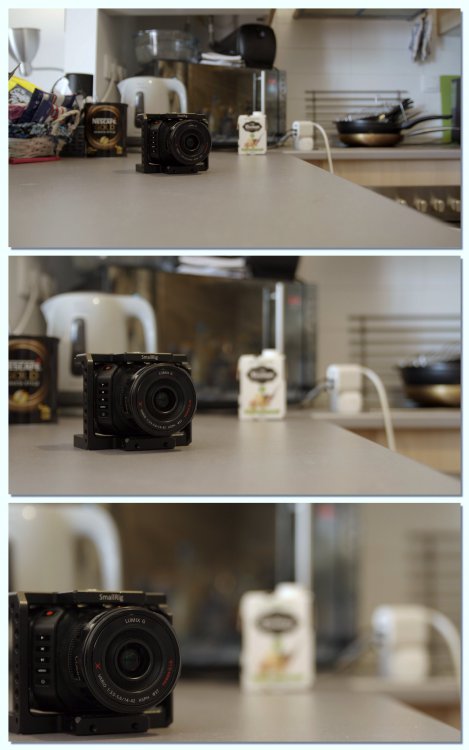
.thumb.jpg.ce6cbd269811cac6f194fc2329e93c3d.jpg)
